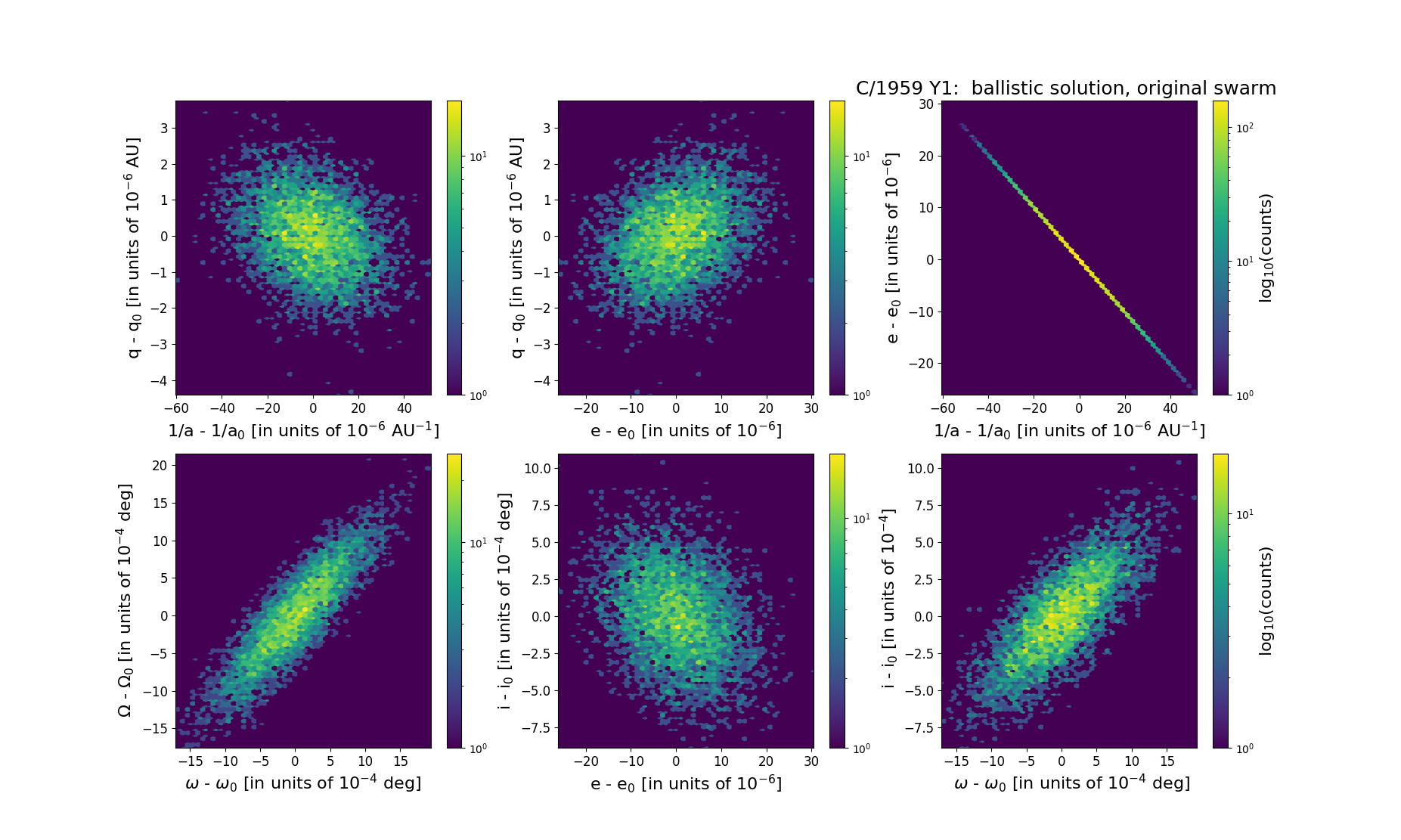C/1959 Y1 Burnham
more info
Comet C/1959 Y1 was discovered on 30 December 1959 by Robert Burnham Jr (Lowell Observatory, Arizona, USA), that is 5 months before its perihelion passage. It was observed until 13 July 1960 [Kronk, Cometography: Volume 4].
Comet had its closest approach to the Earth on 27 April 1960 (0.203 au), 12 days after its perihelion passage.
This is a comet with nongravitational effects strongly manifested in positional data fitting.
Both solutions (GR and NG) given here are based on data spanning over 0.449 yr in a range of heliocentric distances: 1.63 au – 0.504 au (perihelion) – 1.81 au.
This Oort spike comet suffers moderate planetary perturbations during its passage through the planetary system; these perturbations lead to escape the comet from the planetary zone on a hyperbolic orbit (see future barycentric orbits).
See also Królikowska 2014 and Królikowska 2020.
Comet had its closest approach to the Earth on 27 April 1960 (0.203 au), 12 days after its perihelion passage.
This is a comet with nongravitational effects strongly manifested in positional data fitting.
Both solutions (GR and NG) given here are based on data spanning over 0.449 yr in a range of heliocentric distances: 1.63 au – 0.504 au (perihelion) – 1.81 au.
This Oort spike comet suffers moderate planetary perturbations during its passage through the planetary system; these perturbations lead to escape the comet from the planetary zone on a hyperbolic orbit (see future barycentric orbits).
See also Królikowska 2014 and Królikowska 2020.
| solution description | ||
|---|---|---|
| number of observations | 79 | |
| data interval | 1960 01 04 – 1960 06 17 | |
| data type | perihelion within the observation arc (FULL) | |
| data arc selection | entire data set (STD) | |
| range of heliocentric distances | 1.63 au – 0.50 au (perihelion) – 1.81 au | |
| detectability of NG effects in the comet's motion | comet with NG effects strongly manifested in positional data fitting | |
| type of model of motion | GR - gravitational orbit | |
| data weighting | NO | |
| number of residuals | 146 | |
| RMS [arcseconds] | 3.00 | |
| orbit quality class | 2a | |
| orbital elements (barycentric ecliptic J2000) | ||
|---|---|---|
| Epoch | 1664 06 26 | |
| perihelion date | 1960 03 21.82466476 | ± 0.00009480 |
| perihelion distance [au] | 0.50452362 | ± 0.00000100 |
| eccentricity | 1.00006979 | ± 0.00000805 |
| argument of perihelion [°] | 306.626557 | ± 0.000541 |
| ascending node [°] | 252.545867 | ± 0.000587 |
| inclination [°] | 159.618497 | ± 0.000285 |
| reciprocal semi-major axis [10-6 au-1] | -138.32 | ± 15.95 |
| file containing 5001 VCs swarm |
|---|
| 1959y1a1.bmi |

Upper panel: Time distribution of positional observations with corresponding heliocentric (red curve) and geocentric (green curve) distance at which they were taken. The horizontal dotted line shows the perihelion distance for a given comet whereas vertical dotted line — the moment of perihelion passage.
Lower panel (panels): O-C diagram for this(two) solution (solutions) given in this database, where residuals in right ascension are shown using magenta dots and in declination by blue open circles.
Lower panel (panels): O-C diagram for this(two) solution (solutions) given in this database, where residuals in right ascension are shown using magenta dots and in declination by blue open circles.
